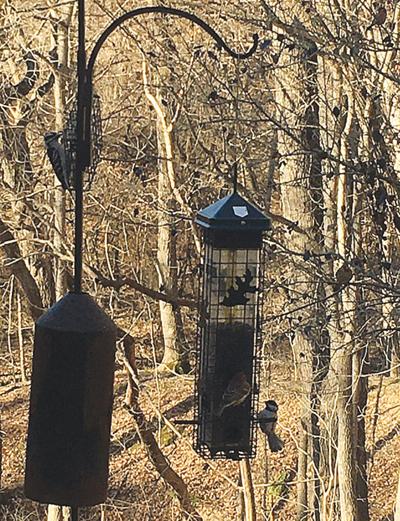Obviously the food is free for them and not for me, but I can get all I need at reasonable prices from my local Buchheit store. A combination of black oil sunflower seeds and the cracked corn, wheat, milo and millet simply called Wild Bird Mix attracts a great variety of birds.
The hometown favorite is probably the northern cardinal, for its association with the local baseball team as much as for the bright color it brings to a bleak winter background. They are big fans of the sunflower seeds; I guess they have that in common with the ballplayers, too.
Both male and female cardinals can be bullies at the feeder. They’ll take a spot on a perch and then spend more time trying to keep other birds away than actually eating seeds. They are the biggest of the common songbirds around the feeder and are always willing to throw their wings and weight around.
Despite the redbirds’ diligence, some quick-hitting birds still retrieve plenty to eat with their dash-and-dine strategy. They snatch a seed and then quickly retreat to a nearby tree to crack the shell and get their reward. Sometimes they will get the cardinal to chase them from perch to perch before grabbing and going.
The tufted titmouse is a swoop-and-scoot expert. With a pointed crest, he looks a little like a smaller version of his cardinal nemesis, but with a gray back, wings and crown. Males and females look much the same and can be hard to spot against the gray tree bark, but their non-stop chatter makes them easier to locate.
Carolina and black-capped chickadees, from the same family as the titmouse, are experts at the in-and-out game as well. A bit more bold than their cousins, they will roost closer to the feeder, waiting for an open opportunity.
The two chickadees are almost identical, and most easily distinguished by their location. Those in the northern half of the U.S. are black-capped, while those in the south and east are Carolina chickadees. The dividing line swoops straight across Missouri, so we may see both in Jefferson County. Black-capped chickadees have a tiny bit more white on their wings and a slower pace to their song routines. Those slight differences are hard to distinguish.
Other year-round residents likely to find their way to my stash of seeds are white-breasted nuthatches. Similar in color to the chickadees and titmice, their unique trait is traveling down tree trunks headfirst. They even hang upside down on the bird feeder while getting a bite to eat.
The community at the feeder in the winter also includes Carolina wrens, house finches and American goldfinches, whose feathers are not the familiar bright yellow of spring and summer. Several different sparrows are winter residents in the area, and the dark-eyed junco “snowbird” is a regular on the ground underneath the feeder, hopping around and hoping for scraps.
Four different types of woodpeckers can be attracted to a suet feeder filled with seed-infused blocks of animal fat. The red-bellied woodpecker, with more distinctive red on his cap than on his front, is not to be confused with the redheaded woodpecker, which is bright red from the neck up. His feathers are more solid black and white rather than the zebra stripes of other woodpeckers.
Downy and hairy woodpeckers are almost identical except for their size. The downy version is about the same size as a wire feeder cage. The hairy woodpecker has a longer bill and looks large compared to the feeder as he hangs on and eats.
My favorite of the bird feeder woodpeckers is the common flicker. There is nothing ordinary about him, at least not in comparison to the other species. He is larger than all but the pileated woodpeckers, which are less frequent guests at the feeder. The common flicker’s brown color is unique and his wings hide a bit of golden yellow. Both males and females have black bibs at the base of their necks, and males are distinguishable by a smart-looking mustache.
Occasional and accidental bird visitors add a real treat to backyard bird-watching, including the hawks, who come looking for birds rather than seeds. To my chagrin, the scheming squirrels still get more than their fair share.





